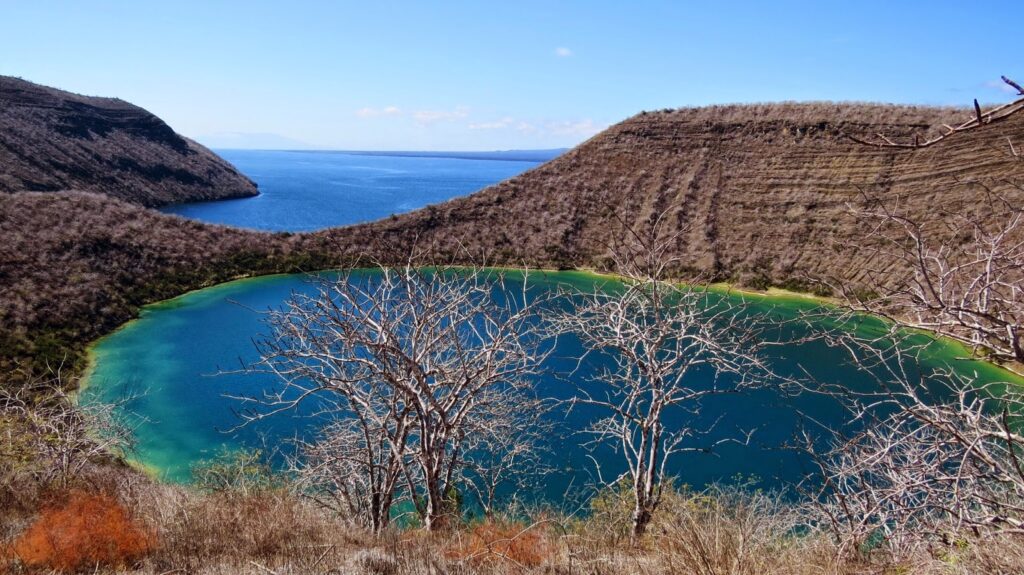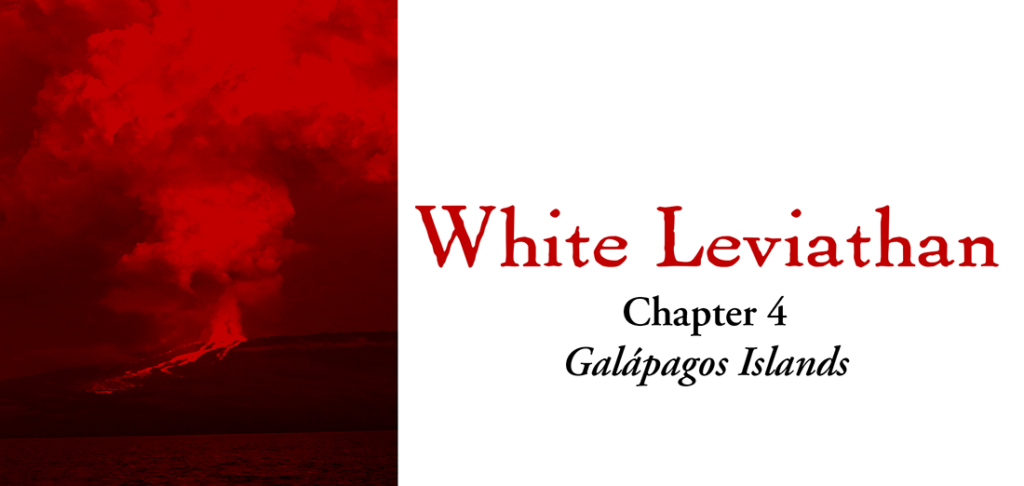Galápagos Islands: Banks Cove
- At November 16, 2022
- By Great Quail
- In White Leviathan
 0
0
7) Banks Cove
Albemarle Island, June 24 to July 2(?), 1845
If now you desire the population of Albemarle, I will give you, in round numbers, the statistics, according to the most reliable estimates made upon the spot:
Men, none
Anteaters, unknown
Man-haters, unknown
Lizards, 500,000
Snakes, 500,000
Spiders, 10,000,000
Salamanders, unknown
Devils, do.
Making a clean total of: 11,000,000
exclusive of an incomputable host of fiends, anteaters, man-haters, and salamanders.
—Herman Melville, The Encantadas, Sketch Fourth
A) Banks Cove
Banks Cove is a natural anchorage located in the submerged remnants of a littoral cone. Protruding from the western side of Albemarle like a horseshoe, the seaward wall of the cone has collapsed, creating an entrance into a roughly-circular bay. The cove has long served as a haven for whalers, but the Quiddity finds itself alone as it drops anchor beneath glowing skies. A few sailors glance nervously to the northeast—rising 4350 feet above Banks Cove is another volcano, its dome wreathed by clouds and its slopes tangled with saltbush. Known today as Volcán Darwin, the volcano hasn’t erupted for decades, a statistic not exactly appreciated by the anxious sailors. Captain Joab sets reduced watches and orders Natty Weeks to issue extra rations of grog—“A drink for Tūtū Pele, men. She spared us tonight, but she’s a thirsty mistress. Best pay her respect.”
| Volcanic Vocabulary Also called pyroclastic cones or tuff cones, littoral cones are formed when magma comes into contact with water and triggers a steam explosion. They’re a distinguishing feature of the Galápagos Islands, and are sometimes called “tuff craters.” Unlike a proper crater, however, a littoral cone lacks a magma vent, and is therefore considered a pseudo-crater or rootless cone. And while we’re on the subject, “tuff” is the general term for solidified volcanic ash. Lightweight, porous, and easy to sculpt, tuff has been used as building material by many ancient cultures from Italy to Hawaii—the famous mo’ai heads of the Rapa Nui are made from tuff. The most important igneous rock in the Galápagos Islands is basalt—a finely-grained, dark gray rock formed by the cooling of iron-rich magma. The islands also have their share of scoria, the spongy-looking rock formed when magma cools in the air; and obsidian, the black “volcanic glass” formed from rapidly cooling lava. While these distinctions may fascinate the likes of Professor Lowell, to contemporary sailors it’s all just cinders and clinkers! |
B) A Day of Duties
The morning arrives overcast and gloomy, the skies ashy from the eruption. A faint, sulfurous odor hangs in the air, and even the usual gaggle of seabirds appear uncharacteristically ruffled. The officers declare a five-day anchorage—after all, this is the last dry land the men are likely to see for a long time! Mr. Whipple procures a bolt of sailcloth and erects a pavilion on shore, while the men sling hammocks between any available supports. The crews are assigned their duties—shipboard repair and maintenance, cleaning ash from the decks, replacing burnt rigging and scorched sails, gathering firewood, hunting for game, and of course, the inevitable turpining. The repairs may be narrated; or if the Quiddity suffered significant structural damage in the fire, addressed using the repair system described in the “Quiddity Damage Tables.” Those assigned to hunting and turpining are instructed to keep a lookout for “one Mr. Tarnmoor,” a “castaway harpooneer” of particular interest to Captain Joab—“I understand he trades terrapin oil at a nearby lagoon.”
C) Exploring the Cove
Like most of the Galápagos Islands, Banks Cove is covered with saltbush, prickly pear, and palo santo trees, with a few mango groves growing along the shore. While blue-footed boobies and brown pelicans are the most abundant wildlife, the black marine iguanas are the most fascinating. Lounging on their rocks, they eye the sailors warily, prompting Paddy Garcia to make the sign of the cross—“Dragons from hell, they are!” A popular anchorage since the buccaneer days, the cove is well-worn by passing sailors, its rocks covered by decades of graffiti—the names of ships and seamen, dates of visitation, crude jokes, lewd depictions of mermaids, unsubstantiated boasts. Any Science roll discovers a certain noteworthy name etched into a rock: “C. Darwin 30th Sept. 1835.” (Charles Darwin published his Journals and Remarks, otherwise known as The Voyage of the Beagle, to great acclaim in 1839. On the Origin of the Species won’t be published until 1859.)
The Message
Another flooded cone some 200 yards from shore forms a cozy saltwater lagoon. (Today this is called Lago Darwin.) The path to the lagoon brings travelers to a sad, but not uncommon sight—a marker for a lost comrade. A splintered oar has been pounded into the ground near a clutch of palo santo trees, the name TURRICK painted on the blade in clumsy black lettering. A pair of kegs is lashed to its base. The left keg is filled with fresh water, the right keg holds ship’s biscuit, a knife, and a Seaman’s Friend Society Bible.
 Banks Cove with Lago Darwin and palo santo trees (From Galapagos Eco Lodge)
Banks Cove with Lago Darwin and palo santo trees (From Galapagos Eco Lodge)
Inside the Bible is a letter. It reads, “Dear Geoffrey; we searched and waited for three days. May God bless you, and may you return home to New Bedford. The wishes and prayers of the crew are with you. Go you with God, and keep His ways. Capt. Peabody, Master of the Osprey. June 23rd, 1845 A.D.” (Handout: Osprey Letter.)
D) Evening Revels
Once the ship has been scrubbed clean and the hunters have returned, Joab allows the exhausted men an evening to “blow off steam from their o’erworked boilers.” They create a small bonfire near the pavilion and celebrate with music and grog. Seph Lovecraft and Zimri Folger attempt to elevate the proceedings by staging tableaux vivants of scenes drawn from literature, history, and the voyage itself. The first sailor to correctly identify a scene is awarded with a dollop of “the good stuff,” a bottle of Kentucky whiskey produced by Natty Weeks from his inexhaustible stores. (If the Keeper is interested, she may recruit the players into staging a few amusing tableaux vivants of memorable incidents from the campaign so far!) (Also, Natty’s bourbon tastes exactly like Jefferson’s Ocean; I’m just saying…)
The Quids enjoy themselves until midnight, after which they tumble to their hammocks or just collapse on the ground—after all, most have spent the last week crawling over volcanic rocks, backing down terrapins, and carrying bundles of firewood. A good night of rest is quite welcome! Mr. Coffin sets the watches; any character chosen for the Lowell Expedition is exempt.
E) El que susurra en la oscuridad
Sometime around 2:00 am the watchmen are allowed to make Listen rolls. (As these are likely NPCs, the Keeper may assign them temporary players.) A successful roll hears something muttering in the dark, a low whispering. Fluency in a Romance language or a successful Education roll identifies the whispering as Spanish. A Language (Spanish) roll catches a few phrases: “Sí sí sí,” “no son como los demas,” and “el maestro ha regresado.” (“Yes, yes, yes,” “not like the others,” and “the master has returned.”) The whispering stops the moment someone attempts to investigate it. Rousing Coffin and dispatching a search party produces no results. The Keeper may allow a Hard Tracking roll, but there’s no trace of the whisperer in darkness.
White Leviathan, Chapter 4—Galápagos Islands
[Back to Encounter 6, The Eruption | White Leviathan TOC | Forward to Encounter 8, Tarnmoor’s Lagoon]
Author: A. Buell Ruch
Last Modified: 19 August 2023
Email: quail (at) shipwrecklibrary (dot) com
White Leviathan PDF: [TBD]

